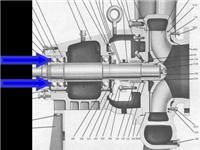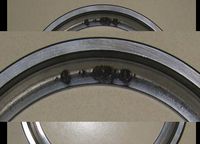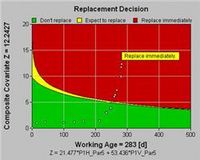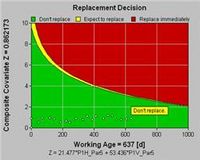EXAKT reduces failures at Canadian Kraft Mill
In 2005, the Toronto based CBM Lab collaborated with a Canadian kraft pulp mill operator to investigate the high incidence of unpredicted failures among a small group of its fleet of Gould pumps.
SUMMARY:
In 2005, the Toronto based CBM Lab collaborated with a Canadian kraft pulp mill operator to investigate the high incidence of unpredicted failures among a small group of its fleet of Gould pumps. EXAKT, developed by the University of Toronto’s CBM Lab (Condition-Based Maintenance Laboratory), is an advanced failure prediction software package. By analyzing the pump failures, EXAKT provided a statistical decision tool to accurately predict whether the mill could continue to run the pump until the next shutdown. Four key results were obtained:
- The Mean Time Between Replacement was reduced by 7%
- Retroactively applying this would have prevented 10 of 11 actual failures
- Resulting in a cost saving of over 30%
- The mill’s Maintenance Engineers and Vibration Specialists approved both the EXAKT model and the approach – thus paving the way for its use elsewhere in the mill.
Three important lessons were learned:
1. although many of the datapoints turned out to not be predictors of failure, mill management decided to retain the data current collection process to use for defining and fixing “the next weakest link”.
2. to achieve the optimum replacement strategy, failure probabilities must be combined with breakdown costs – both repair costs and lost production costs
3. Exakt has acted as an enabler to drive forward the work to correct the recurring issues with these pumps.
BACKGROUND AND OBJECTIVES:
This mill produces over 300,000 tons of Kraft Pulp each year – pulp that is destined for the converting mill and then on to market as facial tissues, paper towels and similar products. With the current acute stress on the market pricing for pulp and paper, bringing costs down and production up are key objectives for the mill’s 400 employees. Hence eliminating or substantially reducing the frequency of pump failure was clearly the key objective. However management was also seeking a way to balance the normal production pressure to keep running versus the cost of a failure. The missing link was a clear understanding of the probability of failure – this is EXAKT’s task.
Typically in these situations, three types of failure cost are recognised:
1. the cost of a breakdown repair (damage to the equipment, expedited parts, emergency and overtime crew costs etc)
2. the cost of lost production caused by the breakdown or slowdown
3. the loss of reputation as a consistent and reliable supplier, potential safety or environmental costs, potential penalty payments for non-supply for example; because of the difficulty of measuring this, it was decided to exclude this category of costs from the calculation.
METHODOLOGY:
The analysis started with a review of the mill’s current data to evaluate its consistency, accuracy and adequacy for model building. The units being examined were Gould 3175L pumps which were used 24/7. In anticipation of later capacity expansion (which in fact did not occur), the pumps were originally deliberately over-sized. To compensate, the pumps were run below their best efficiency point by throttling the discharge flow – thus causing excessive load on the thrust bearings.
33 bearing histories were examined in 8 pump locations, embracing 11 failures. For each of these, seven measurements were analysed – five different vibration frequency bands, and the overall vibration reading plus the bearing’s acceleration data.
Lesson learned #1: Although only two of seven streams of CBM data collected and analyzed had any significance for failure prediction, it was decided to retain the remainder for future reliability analysis.
To include the all-important event data, operating starts, out-of-service intervals and failure dates were extracted from the CMMS work history database.
From this data, a statistical model that would correlate the condition monitoring data with actual failure or potential failure events was determined.
Lesson learned #2: combining failure probabilities with breakdown costs prompts the selection of the optimum replacement interval.
An EXAKT Weibull Proportional Hazards model was developed to identify possible correlations between the vibration readings, the acceleration data and the units’ potential and functional failures for each key failure mode. As a result, only two of the variables were proven to be predictors of failure. Although time and effort could potentially be saved by avoiding the collection and analysis of this data, management is continuing the current collection for use in further reliability analyses.
Using the company’s estimate of the average ratio of 3.2:1 between breakdown cost and preventive replacement cost, plus the failure probability associated with each significant risk variable, the EXAKT decision model identified the optimum conditions under which the PM should be performed. This model balances the failure probability with the relative costs of prevention versus breakdown. As each new set of inspection data is received, the model recalibrates and returns a revised optimal interpretation of the CBM data.
The recommended EXAKT policy resulted in an average 7% reduction (from 571 to 529 days) in the PM task intervals, which caused a significant shift from reactive to preventive maintenance, and produced savings of about 30% for these failure modes.
The EXAKT prediction model answers the questions – Should the company keep the unit in operation until the next scheduled outage? Or should they take preventive action prior to the shutdown?
Exhibit A Exhibit B
The EXAKT decision graphs above show the current status of the equipment and the recent trend. Each datapoint tracks the weighted sum of significant CBM measurements against the working age for a specific pump. As long as the current value is in the “Green Zone” ( the lower segment in Exhibit B), then the equipment can be expected to last until the next scheduled inspection. Readings in the “Danger Zone” (the upper segment in Exhibit A) indicate the company will lose money by continuing to operate and incurring a breakdown - in simple terms, the equipment is overdue for breakdown. Additionally an “expected remaining life estimate” is reported – important for scheduling maintenance on the unit. Maintenance managers now have persuasive data to halt production, undertake emergency preventive maintenance and remove the consequences of a full breakdown.
The “Caution Zone” (between Green and Danger) indicates that the best decision will be to perform maintenance within the next inspection interval. The formula at the foot of the screen calculates the weighted sum of significant monitored variables as determined by EXAKT. The conclusions (“Replace Immediately” and “Don’t Replace” respectively) are shown in the text boxes on the graph.
DATA ADEQUACY:
Lesson learned 3#: a minor, but important correction in the maintenance interval yielded a significant change in costs.
Good failure prediction models depend on data adequacy and data consistency. The EXAKT methodology combines inspection data with key event data , and through rigorous statistical tests, concludes whether the data actually contains predictive capability. Thus EXAKT can guide the design of effective CBM programs.
As additional inspection and event data are collected, the analysis database is augmented – thus providing better and more confident decisions. EXAKT measures and reports on the confidence levels with which the data is interpreted. Hence, as new data is received, the predictive models will be updated and the resulting confidence levels can be monitored in a continuous and measurable improvement cycle.
NEXT STEPS:
With the success of this program, the mill management plan to continue to run the mill at maximum output. By applying EXAKT to manage the replacement of these pumps and to other key equipment, the mill can focus on keeping production losses to a minimum and thereby reducing costs. In the current market conditions, “low cost is king”. At the same time, the company recognises that minor modifications can be made to the information management system to ensure that the data will be readily available for analysis without time consuming CMMS data cleansing processes.
The company is currently evaluating special software tools designed to assist this process – software that has been developed by the UofT’s spin-off company OMDEC Inc, who are responsible for commercializing EXAKT.
CONCLUSIONS:
1. Significant cost reductions were demonstrated – in the order of 30%
2. EXAKT failure prediction and decisions models were successfully developed and tested for the pump’s key failure modes at the 95% confidence level
3. Some condition data were found to be of little or no value in predicting failure; however management decided to retain the collection process intact to aid in further reliability programs.
4. Minor changes to the work order process can enable the mill’s engineers to easily collect and extract the key “as found” data for analysis and the generation of good predictive decision models.



